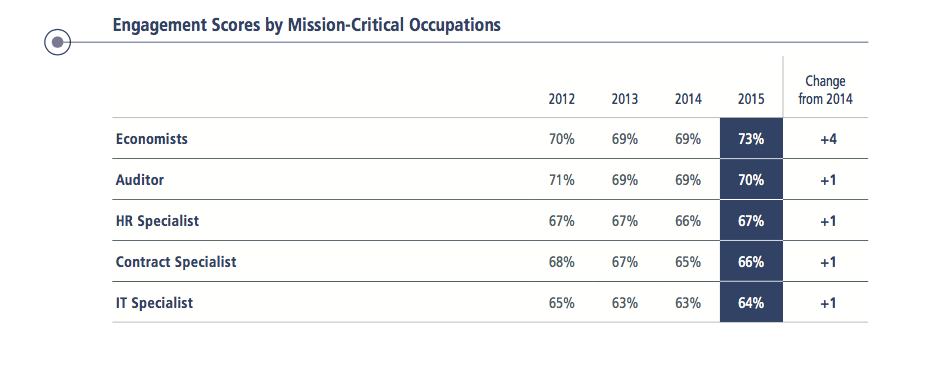Why Are Federal IT Workers So Miserable?

Aleutie/Shutterstock.com
Federal techies report being overworked, undertrained and eyeing the exits.
More than one-third of federal information technology workers don’t think their organizations can recruit top talent. Fewer than half are satisfied with the training they receive on the job. And a sizable chunk of federal techies say they may not stick around much longer.
The gloomy picture of life as a federal IT specialist comes from the 2015 Federal Employee Viewpoint Survey, the annual barometer of federal employee sentiment released Tuesday by the Office of Personnel Management.
Overall, federal employee morale is on the mend after bottoming out last year. But federal techies aren’t bouncing back so quickly.
Federal officials know they have a problem on their hands.
The survey “helps us understand the problem,” with federal IT workers, acting OPM Director Beth Cobert told reporters during an Oct. 6 conference call. “It doesn't give us the answers to the problem.”
Among occupations deemed at risk for staffing gaps, federal IT specialists reported the lowest employee engagement scores, which measures employees’ sentiment across a range of factors.

Just 37 percent of IT specialists said their agencies are able to recruit people “with the right skills,” according to the survey. Only about 34 percent said they aren’t satisfied with the level of training they receive for their jobs, and 39 percent said they aren’t given opportunities to improve their skills once on the job.
In all those areas, IT specialists rank below other “mission-critical” occupations -- which also includes contractor specialists and economists -- as well as the general federal workforce.
More broadly, employees in the fields of science, technology, engineering and math reported heavier workloads than the broader workforce and also complained of insufficient resources to properly do their jobs.
Perhaps most troubling, more than one-third of IT workers -- 37 percent -- say they aren’t planning to stay with their organizations.
Budget Woes, Training Cuts
So, what’s behind the morale drag on federal IT employees?
Well, for one thing, it’s always been a struggle for the government to recruit and retain top-flight tech talent.
In the technology field, there are three key elements that keep employees engaged in their work, according to research by CEB, a member-based consulting firm based in Arlington, Virginia: a strong commitment to innovation, exposure to advanced technologies and work-life balance.
The government generally only gets high marks on the latter, said Kris van Riper, a practice leader at CEB.
Couple that with the budget belt-tightening and short-term funding measures agencies have weathered in recent years, and it’s a “perfect storm,” for drooping morale, said Van Hitch, former longtime chief information officer of the Justice Department.
When agencies can't hire top talent, it can have a "depressing impact" on an organization, said Hitch, who’s now an adviser with Deloitte’s federal practice. "You can't get the skills necessarily that you need; you many need to hire a systems architect or you may need to hire five cybersecurity people and you can't get them. Those are very scarce skills."
Technology is a constantly evolving field, and employees need to keep their skills fresh. Federal employee training has also fallen victim to governmentwide budget cuts in recent years.
“In IT, you live by the skills you have” Hitch told Nextgov. “So, training is a very important part of an IT career. And when that training kind of dies on the vine, then that's another cause for concern."
The lack of training isn’t just making IT specialists rustier at their jobs. It may be making them miserable.
“When people get the right training, then they are happier employees,” said Tim LeFleur with the International Association of IT Asset Managers. “They feel more equipped to handle the curve balls that are going to come up on the job. . . We’ve seen people really take off and soar when they get the right training.” LeFleur, whose organization includes members at many large federal agencies, said he was speaking in general and had not had time to look closely at the OPM survey results.
Eyeing the Exits
Perhaps most concerning, more than one-third of federal techies say they’re actively eyeing the exits. Just 63 percent of IT respondents say they’re planning to stay with their organizations.
Unlike some other mission-critical occupations, IT workers possess skills that translate well to the private job market.
“Particularly given the improvement in the labor market and in the D.C. IT labor market since 2008, there are just more options for them externally,” van Riper told Nextgov. “So, you worry that the people who are most talented are the ones that may be looking, and they're the ones that have probably the easiest chance of landing something on the private sector side.
The survey findings are the first to come out since the Obama administration initiated its “Smarter IT Delivery” agenda last May. A big focus of that agenda is getting “world-class” digital talent to sign up for tours of duty with the government, coordinated by the White House’s U.S. Digital Service team.
The effort appears to be having an impact and shows the government can compete for top talent in certain circumstances, van Riper said.
“One of the things we know about hiring and about employee engagement is connection to mission,” van Riper said. “And having the opportunity to serve your government is an extremely motivating factor for the highest-quality IT people. So, done in the right way, the government can recruit very high-quality IT people by highlighting the fact that you will get to have an impact that you could never have working in a private sector company."
Along with a similar team at the General Services Administration, the White House team now numbers more than 120 staffers and is on track to hit 500 by the end of next year, according to a recent report in Government Technology. But even if the ranks swell to that level, the digital teams will only ever be a small subset of the thousands of the programmers, computer engineers and developers who make up the federal IT workforce.
"Overall, that is going to be a small percentage of the total federal IT population,” van Riper said. “And so there has to be other opportunities to develop in place and to be given the skills and opportunities to work with new technologies."
(Image via Aleutie/Shutterstock.com)


